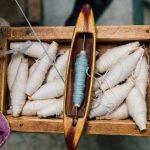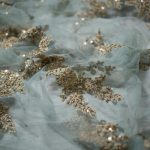You might be surprised to learn that gossamer isn't just a delicate fabric; it's on the verge of transforming the textile industry. As manufacturers increasingly lean towards sustainability and innovative technologies like 3D printing, the potential for this lightweight material is expanding. Moreover, the integration of smart textiles could soon redefine how we interact with our clothing. But how will these trends shape the future of consumer preferences and high-performance applications? The answers could change everything you think you know about textiles.
Table of Contents
Advancements in Manufacturing Technologies
Advancements in manufacturing technologies are revolutionizing how gossamer is produced, enhancing its quality and production efficiency.
You're seeing innovations in automated weaving techniques and cutting-edge fiber blends that make gossamer fabrics lighter yet stronger. These developments allow manufacturers to create intricate patterns and designs that were once cost-prohibitive or too time-consuming.
Moreover, 3D printing is starting to play a significant role in gossamer production. With this technology, you can create custom gossamer structures tailored to specific applications, reducing waste and optimizing material use. Real-time monitoring during production processes allows you to ensure consistency and minimize defects, contributing to the overall quality of the final product.
Sustainability is also creeping into the manufacturing scene for gossamer. Advanced techniques now enable recycling of fibers, ensuring you're reducing environmental impacts while maintaining the finesse of gossamer fabric.
As these technologies continue to develop, you can expect gossamer to be more adaptable and efficient than ever before. This may lead to its integration into a wider range of applications, further solidifying its place in the textile industry of the future.
Integration of Smart Textiles
The integration of smart textiles into gossamer is set to transform the way these lightweight fabrics are utilized across various industries. By embedding sensors and other technologies directly into the fibers, gossamer can adapt to different environments and user needs, making it an exciting frontier for innovation.
Here are three potential applications of smart gossamer textiles:
- Wearable Technology: Imagine clothing that monitors your vital signs and adjusts itself for comfort or performance. Smart gossamer can make this a reality, enhancing athletic gear or medical applications.
- Responsive Interiors: Picture curtains or upholstery that can change color or temperature based on the room's atmosphere. With smart gossamer textiles, you could create dynamic living spaces that respond to light and heat.
- Safety Gear: Think about work uniforms that alert you to hazardous conditions or adjust to temperature changes. Smart gossamer could revolutionize how we think about safety and comfort in labor-intensive environments.
Incorporating these functionalities, gossamer's future looks promising as it embraces the world of smart textiles, ultimately increasing its utility and versatility across multiple sectors.
Emphasis on Sustainable Practices
As consumers become more eco-conscious, the textile industry is prioritizing sustainable practices in the production of gossamer fabrics. Manufacturers are increasingly using eco-friendly materials like organic cotton, recycled polyester, and innovative technologies to minimize waste and reduce carbon footprints.
You'll notice a rise in labs and companies focusing on creating gossamer textiles through processes that consume less water and energy. This shift isn't just a trend; it's becoming essential.
Brands are also adopting transparent supply chains, enabling you to make informed choices about your purchases. It's no longer enough to produce lightweight and elegant fabrics; today's companies are held accountable for their environmental impact.
By opting for sustainable gossamer fabrics, you're contributing to a circular economy that fosters responsible consumption, where materials can be reused and recycled.
Additionally, collaborations between designers and eco-friendly textile producers are sprouting up, leading to innovative, sustainable collections that cater to your style while respecting the planet.
As this emphasis on sustainability grows, you'll likely see gossamer fabrics that not only entice with their delicacy but also align with your values of environmental responsibility.
Evolving Consumer Preferences
With a growing focus on sustainability, your preferences as a consumer are shifting towards gossamer fabrics that not only offer elegance but also reflect your values of eco-consciousness.
You're increasingly drawn to textiles that align with your ethical beliefs, showcasing that style doesn't have to compromise sustainability.
Consider the reasons behind this shift in your choices:
- Eco-Friendly Production: You prefer materials made with processes that minimize waste and reduce your carbon footprint.
- Biodegradability: You're more inclined to choose fabrics that break down naturally, leaving less environmental impact over time.
- Transparency in Sourcing: You seek brands that provide clear information about their supply chains, ensuring that ethical practices are upheld throughout production.
As your awareness of sustainable practices grows, gossamer not only meets your needs for luxury and delicacy but also embodies your commitment to a better planet.
This evolution in your consumer preferences signals a significant change in the textile market, prompting brands to innovate and adapt in line with your values and expectations.
Your choices are powerful, shaping the future landscape of fashion and sustainability.
Applications in High-Performance Wear
Gossamer fabrics are making waves in high-performance wear, offering athletes lightweight, breathable options that enhance their capabilities without sacrificing comfort. When you choose high-performance apparel made from gossamer materials, you'll experience unparalleled freedom of movement. These fabrics are designed to wick moisture away, keeping you dry and cool during intense workouts or competitions.
Imagine sprinting down a track or climbing a challenging route while donning a gossamer-based outfit. You won't just feel lighter; you'll be more agile. The innovative construction of gossamer textiles allows for strategic ventilation, ensuring optimal airflow exactly where you need it.
Athletes across diverse sports are already reaping the benefits. Whether you're a runner, cyclist, or practitioner in team sports, gossamer fabrics provide the perfect fusion of durability and performance. Plus, they're often engineered with UV protection, safeguarding your skin under the sun.
As the demand for advanced performance gear grows, you can expect to see gossamer textiles increasingly integrated into specialized apparel designed for extreme conditions, pushing the envelope on performance standards.
Embrace the future of high-performance wear, where every detail is crafted for your advantage.
Frequently Asked Questions
How Does Gossamer Compare to Traditional Textiles in Durability?
Gossamer significantly outlasts traditional textiles in durability. It resists wear and tear better, ensuring your garments maintain their shape and integrity longer. You'll appreciate its lightweight feel while benefiting from enhanced longevity compared to conventional fabrics.
What Are the Costs Associated With Gossamer Production?
When you consider gossamer production costs, you'll notice they can vary significantly based on materials and processes. Generally, higher quality fibers might increase costs, but their unique properties often justify the investment for specialized applications.
Can Gossamer Be Recycled After Use?
Yes, you can recycle gossamer after use, but it depends on the specific materials involved. Some recycling processes may work effectively, while others might not, so check local facilities and guidelines before proceeding.
What Challenges Exist for Gossamer Scalability in the Market?
You'll face challenges like production costs, specialized machinery requirements, and limited materials sourcing when scaling gossamer in the market. Overcoming these obstacles is crucial to expand its adoption and ensure economic viability in the textile industry.
Is Gossamer Effective in All Climate Conditions?
Gossamer's effectiveness varies in different climates. It excels in moderate conditions but struggles in extreme temperatures and humidity. You'll need to consider specific environmental factors when assessing its suitability for your intended use.
- How Does Ring Spun Cotton Affect Garment Fit and Shape Retention? - August 13, 2024
- What Are the Challenges in Producing Ring Spun Cotton? - August 13, 2024
- Is Ring Spun Cotton Suitable for Plus-Size Clothing? - August 13, 2024







